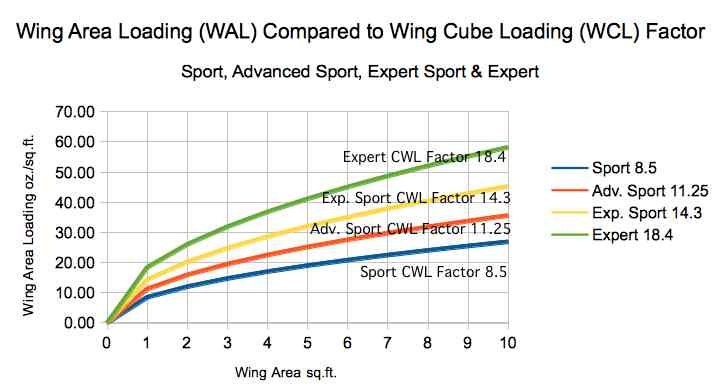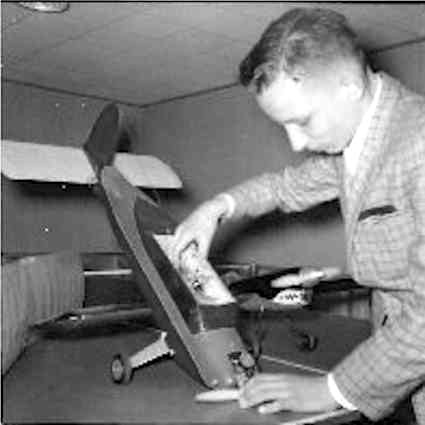 |
Flying High With Electric Power!
The Ampeer ON-LINE!
Fly the Future - Fly Electric! |
|---|
Site Table of Contents
| President: | Vice-President: | Secretary-Treasurer: |
| Ken Myers | Richard Utkan | Rick Sawicki |
| 1911 Bradshaw Ct. | 240 Cabinet | 5089 Ledgewood Ct. W. |
| Commerce Twp., MI 48390 | Milford, MI 48381 | Commerce Twp., MI 48382 |
| (248) 669-8124 | (248) 685-1705 | (248) 685-7056 |
 | ||
| Board of Directors: | Board of Directors: | Ampeer Editor |
| David Stacer | Arthur Deane | Ken Myers |
| 16575 Brookland Blvd. | 21690 Bedford Dr. | 1911 Bradshaw Ct. |
| Northville, MI 48167 | Northville, MI 48167 | Commerce Twp., MI 48390 |
| (248) 924-2324 | (248) 348-2058 | (248) 669-8124 |
| Mailed Ampeer printed subscriptions are no longer available.
The Ampeer is FREE on-line in Acrobat .pdf format and HTML with active links! | ||
| The Next Meeting:
Date: Thursday, April 17 Time: 7:30 p.m. Place: Ken Myers' house, Commerce Twp., MI 48390 | ||
| Measuring Maximum Servo Torque Revised Ken Myers corrects a HUGE oops in his March article on this topic. Sorry! | Min-E Mambo Specifications Ken shares the Ready to Fly specifications of his Min-E Mambo, electric conversion, tribute and restoration project. Link to the plans page. |
| Upcoming Keith Shaw Birthday Party Electric Fly-in 2014 - Info and map for this upcoming event. | Two Reasons for Scaling Model Airplanes and How I Do It Ken explains how and why he scales model planes. |
| Head's Up on a New, Powerful Charger, Gary Gullikson tells us about is new Vista Power Quadplay Q3620. | 30th Annual Mid-America Electric Flies 2014, links to the Flyer and map and hotel info for the 2014 Mid-Am. |
| Live Wire Rebel Remembered, Rick Sawicki, EFO member, shares thoughts on his old Live Wire Rebel. | |
By Ken Myers On the afternoon of February 27, the day the March 2014 Ampeer was posted, I received the following email from Alan Bedingham in the U.K. Er, you may want to revise your article on servo torque. Dividing a torque by a length gives a force (in your example oz) not another torque. "For multiplying, the inverse of 0.5625 = 1.777
"A servo arm of 2" was used next. The inverse of 2 = 0.5. 55 oz-in * 0.5 = 27.5 oz-in of torque" (nope, oz of force). "The longer the arm, the less the available torque." (nope, the longer the arm, the lower the force available). The torque remains the same regardless of the arm length. Regards
After I slapped my head several times and kicked my behind, I did something I'd never done before. I revised and reposted the March 2014 Ampeer on March 28 to correct the article. I thank Alan for his observation and really appreciate him letting me know the 'error of my ways'. Min-E Mambo Specifications
In the March Ampeer, I presented my electric powered, tribute and restoration of a 1963 Sterling Models Minnie Mambo, which I call the Min-E Mambo. Wing span: 35-9/16" or 903.6mm Wing area including tips: 217 sq.in. or 14dm2 Fuselage length including rudder: 24-9/16" or 623.4mm Ready to Fly Weight: 16 oz. or 453.6g Wing Area Loading: 10.62 oz./sq.ft. Wing Cube Loading: 8.6 Watts in using Cox 6x4 Gray: 49.5 RPM: 10,858 Watts in per lb.: 49.5 Center of Gravity (CG): 2-1/16" or 52.4mm from the leading edge as marked on the original plans 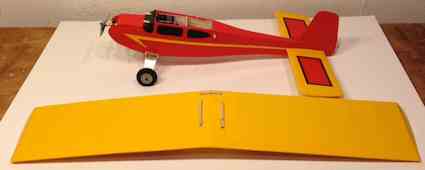 Photo shows the fuselage "crackers" and forward wing stop. The Min-E Mambo plans and construction notes. Upcoming Keith Shaw Birthday Party Electric Fly-in 2014 The Balsa Butchers will once again be hosting the "Keith Shaw Birthday Party Electric Fly-In" at their field near Coldwater, MI. The event will take place on May 31 and June 1, 2014. Contest Director: Dave Grife - E-mail: grifesd@yahoo.com or Phone: 517.279.8445
The Flying Field will be open Friday, May 30 for early arrivals Saturday, May 31, hours are from 9 a.m. 'til 5 p.m.
Landing Fee is $15 for the weekend. Directions: Quincy is approximately 4.5 miles east of I-69. Clizbe Road is approximately 1.6 miles east of Quincy. The Flying site is approximately 1.5 miles south of US-12 on the west side of Clizbe Road. 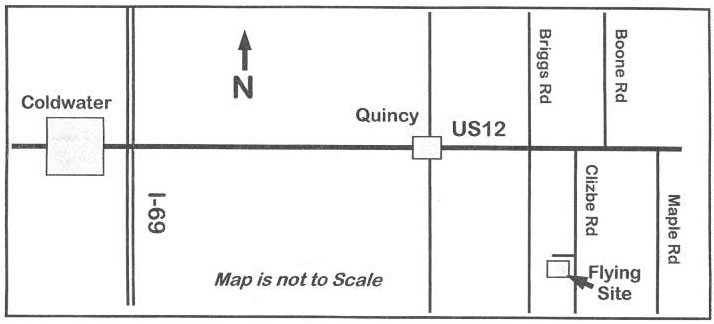
Ken Myers On December 27, 2013 a thread was revived on RC Groups. The thread is called "Model Aviations wing cubed loading article". Peter Angus brought up the topic of scaling and gave his formulas and thoughts regarding scaling. Link to his Web site. For me, there are two reasons to scale an existing airframe. The first, for the model builder, is to change the size of an existing model and have the scaled version fly the same mission in a similar manner. The second reason to scale is to create a 'scale' model of a full-scale aircraft. To scale an airframe, model or full-scale, I created an Excel workbook with two spreadsheets. One spreadsheet uses full-scale information to create a scaled model and the other uses an existing electric model to be rescaled. To scale an airframe, model or full-scale, up or down, requires the use of a linear measurement. If the desire is to produce an airframe one-half the size of the original airframe, the wing area cannot be simply divided by 2. While a 1/2 size Min-E Mambo would have a wingspan of 35.5625 / 2 = 17.78125 inches, it would have a wing area of 54.25 sq.in. If I wanted the scaled version to fly in the same manner as the 'full-size' Min-E Mambo it would have to have the following specifications.
Many of the requirements are not scaled in a linear fashion. The spreadsheet handles all of the variables, so no 'math' is required of the user. For the curious, if the desire was to build a model with 1/2 the area of the Min-E Mambo, it would have a wing area of 217 sq.in. / 2 = 108.5 sq.in. and wing span would be 25-5/32". Again, don't worry about the math, just use the spreadsheet. My ElectroFlying Fusion, low-wing, sport plane has a measured wing area of 558.45 sq.in. and wing span of 57.93 inches. The ready to fly weight is 74.615 ounces. It has a wing area loading (WAL) of 74.615 oz./(558.45 sq.in. / 144) = 19.24 oz./sq.ft. It has a wing cube loading (WCL) of 74.615 oz./(558.45 sq.in. / 144)^1.5 = 9.77 It uses an AXI 4120/18 which provides a maximum of 510 watts in using a 6S "A123" 2300mAh pack and spinning an APC 12x10E at 7750 RPM. The 74.6 oz., or 4.66 lb., plane has 109.38 watts in available for each pound of plane weight. At 7750 RPM the prop has a pitch speed of 73.4 mph [(7750 RPM * 10" pitch)/1056]. It has a stall speed of approximately 16.23 mph. The pitch speed to stall speed ratio is 4.52:1, which provides very good performance in the vertical and loop size. The data required for the spreadsheet input:
That is all that is required. I wanted a smaller version that could use a 3S "A123" 2300/2500mAh pack and yet still fly in a similar manner with a similar 'feel'. I also wanted it to present itself in the air in a similar manner. My 3S "A123" 2300/2500mAh pack planes have wing areas between 325 sq.in. and 415 sq.in. To arrive at something in that wing area range, I simply input a percentage in the Scaling Factor cell on the spreadsheet to try. When 90% (0.9) was input to the Scaling Factor cell on the spreadsheet, the result was a wing area of 452 sq.in. and weight of 54.4 ounces. Based on my previous experience with S3 "A123" power systems, that was too big and heavy. When 80% (0.8) was input, the result was 357.4 sq.in. and 38.2 ounces. I could have used that and it would have been fine. I decided to go with 82% (0.82). It yielded a 375.5 sq.in. wing at about 41.14 ounces. The results from the spreadsheet for 82%.
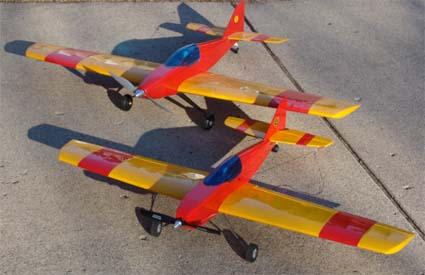
How did it work out? The new model, which I named the Fusion 380, has a measured RTF weight of 40.6 oz. I was able to come very close to the target weight and both planes fly in a similar manner and with the same perceived "feel". The ElectroFlying Fusion has a WAL of 19.24 oz./sq.ft. and the Fusion 380 has a WAL of 15.68 oz./sq.ft. They both have the same WCL of 9.77. Using the wing cube loading (WCL) best explains why they fly in such a similar manner. For me, using the wing area loading (WAL) is not a very good way to compare the ease of flying or flyability of different size models of similar design as it requires extra math to relate the WAL to the size. 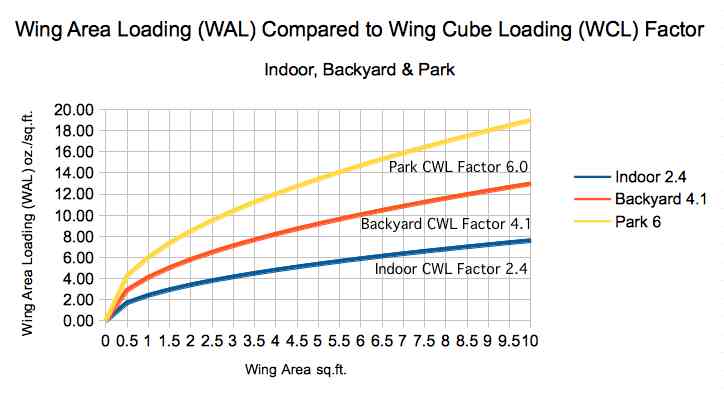
The graphs show the relationship of the wing area loading (WAL), wing cube loading (WCL) and wing area in square feet. Using the WAL to compare the flyability of full-scale aircraft works out well because they are all built to the same scale. Using the WCL for models gives a better flyability indication because the model can be built to any scale and WCL takes this into consideration. The following full-scale loadings are based on the empty airframe weight. Of course fuel and pilots would need to be added for full-scale flight. The numbers are just for comparison purposes.
While both the WAL and the WCL indicate the 'ease' of flying, or flyability levels, of these full-scale types, only the WCL transfers well, without extra math, for comparing similar models or these aircraft in various sizes. For comparison, several WCL were noted in "Aircraft Performance Parameters Revisited" by Roger Jaffe, Model Builder, June 1994. Gliders 4 Trainers 6 Sport Aerobatic 9 Pattern 11 Racers 12 Scale 10-15 My original article on the wing cube loading (WCL), which was updated on January 3, 2014, is still available on the EFO Web site. The following listing only gives an idea of the plane types. An Excel workbook, with much more data is available. Based on the collected data, seven wing cube loading (WCL) levels were created. The level averages, based on the collected data, were used to create graphs 1 and 2. Level 1, WCL 0.00 - 2.99, includes mostly indoor type models and those that can be flown outside in very light winds, only level with no internal combustion powered planes. Avg. WCL 2.39 Level 2, WCL 3.00 - 4.99, includes mostly backyard type models that can be flown indoors in larger venues and outside in low wind conditions, includes a few internal combustion powered planes. Average WCL 4.10 electric, 4.46 internal combustion Level 3, WCL 5.00 - 6.99, includes park flyers, sailplanes, biplanes, 3D planes. Average WCL 5.98 electric, 6.09 internal combustion Level 4, WCL 7:00 - 9.99, includes sport types, biplanes, scale, some 3D planes, and pattern. The greatest number of RC planes are found in this category. Avg. WCL 8.51 electric, 8.60 internal combustion Level 5, WCL 10.00 - 12.99, includes advanced sport types, sport scale and sport scale warbirds, and some twins. Avg. WCL 11.24 electric, 11.44 internal combustion Level 6, WCL 13.00 - 16.99, includes expert sport types, scale, scale warbirds, and some twins. Avg. WCL 14.31 electric, 14.67 internal combustion Level 7, WCL 17+, includes planes for the expert fliers only, heavier twins and other multi-motor, true scale, and true scale warbirds. Avg. WCL 17.50 electric, 18.44 internal combustion The levels are purely arbitrary. A plane with a WCL on the high end of one level will most likely fly in a similar manner to one on the low level of the next higher WCL level. The Fusions are at the high end of level 4. When model aircraft kits were being produced, a manufacturer might offer similar high-wing trainer designs in 20, 40 and 60 sizes. The numbers indicated the recommended engine displacement for glow 2-stroke engines; 0.20 cu.in., 0.40 cu.in. and 0.60 cu.in. Today's ARF suppliers do something very similar. Horizon Hobby sells, or sold, a series of low-wing sport planes that they called Pulse. The smallest is called the E-flite Mini Pulse XT ARF and largest was the Hangar 9 Pulse 125 ARF. Based on Horizon Hobby's data, using the heaviest weight noted, the Mini Pulse has a wing area loading (WAL) of 11.78 oz./sq.ft. and the Pulse 125 has a WAL of 20.85 oz./sq.ft. If wing area loading (WAL) is used to compare the flyability of the similarly designed airframes, the capable and experienced RC pilot should find the Mini Pulse 'easier' to fly than the Pulse 125. In reality, the Mini Pulse does not seem 'easier' to fly. The wing cube loading (WCL) does a better job of predicting flyability for a given plane. The WCL for the Mini Pulse is 7.78 and the WCL for the Pulse 125 is 7.72. The experienced RC pilot should find their flight characteristics quite similar. Of course there will be a bit of a noticeable difference in the air due to the actual physical size difference, but overall, there should be a similar 'feel' to the two airframes. The experienced RC pilot should find both equally 'easy' to fly.  Table 1 shows the data for the rest of the planes in the Pulse series arranged from 'easiest to fly' to 'hardest to fly' using both loading systems. The table also indicates which ones will fly with a similar 'feel' to the pilot. The wing area loading does not suggest the same 'flyability', because of scale, as the WCL. The wing area loading/wingspan is also shown on the table for comparison and does indicate the same 'flyability' in a different presentation. My flying buddy, Arthur Deane, regularly flies both the Mini Pulse and Pulse 25. I asked him to share some anecdotal information about the two planes. "I first flew the Mini Pulse. I used the recommended standard set up with an E-Flite 450 motor. The plane flew well and I had many enjoyable flights. It got to the point that I could not stand its blue trim anymore. I ended up changing the shape of the tail surfaces and recovering it in a different color scheme. This winter I am recovering it with a new color scheme and a trying to change the appearance with the revised tail surfaces and an open cockpit. All for a change of appearance. Maybe I will put in a 480 motor. Overall the plane flew well. It did what I wanted and landed well in calm conditions. Landing with a crosswind was more difficult. I had to consistently work the controls to keep it on the glide path. I finished my Pulse 25e as a 32e version with a 32e equivalent motor. I was very pleased with the plane. It did everything I asked it to do. Landings are a joy. I set the plane up on glide path and leave it alone and enjoy it coming in. The Mini Pulse is fun to fly particularly in a small field. However, I much prefer the 32e version. The extra weight reduces the effects of gusts and crosswinds. It is a much more enjoyable experience. Just what you would expect. I have one complaint for both versions. The landing gear attachment in the fuselage is not strong enough. Basically a flaw with all laser cut ARF's. I have a modification for both versions that uses a wood block, small screws and gorilla glue to reinforce the attachment. Over time the fuselage lower longeron's over the wing deteriorate and I have a mod for both versions that reinforces the lower longeron with a hardwood strip." Table 1 demonstrates some of the 'flyability' differences noted by Arthur. In reality, the scaling of speed and power is not linear. In a world where we could fly models in 'scale air', 'scale gravity', scale building materials and 'scale power', they could be linear. A goal in scaling the speed and power is to have the 'changed size' plane present itself in the air in a similar manner as the plane being scaled. In other words, for a sport plane like the Fusion 380, it should appear to have a similar vertical climb and loop size based on its size when compared to the original Fusion. The equations in the spreadsheets allow for this. Previously noted from spreadsheet for the Fusion 380 were:
The power system actually used in the Fusion 380 consists of a Scorpion S-3020-11 (a special turn wind I had created for this plane), a Scorpion Commander V2 45 amp ESC, a 3S "A123" 2300mAh pack turning a Master Airscrew 10x8 G/F 3 series prop (not a 3-blade prop). The measured power system data showed 305 watts in at 8715 RPM. Using the scaling and power system formulas in the spreadsheet created a smaller version of the ElectroFlying Fusion that presents and feels very similar in the air. Except for flying the Fusion 380 a bit closer to the flight line on the far side of the pattern, it "feels" almost identical to flying the larger version in every respect. Many RC pilots enjoy flying a model that looks like a full-size aircraft. It doesn't matter to the majority of them whether it flies or presents like the full-scale version. A large number of RC models based on full-size aircraft have a lower WCL than the full-size and a higher power to weight ratio. Because of this, the RC pilot can choose to try and fly it in a similar manner to the full-size aircraft or just have 'fun' flying it 'fast' and doing aerobatics that are beyond the capability, or permissibility, of the full-scale aircraft. The parkzone Ultra-Mini Cub resembles a full-scale Cub. The Hempel J-3 1/2-scale Cub ARF with a ZDZ-210 also looks like a full-scale Cub. Neither of the models fly like a full-scale Cub unless the pilot chooses to try to do so. Unless the pilot tries very hard to do so, they do not present or represent themselves in the air like a full-scale Cub. With a solo pilot and fuel, the flying weight of a Cub is about 1000 lb. yielding a WCL of 6.71. The parkzone Ultra-Mini Cub has a WCL of 4.15 and the Hempel 1/2-scale has a WCL of 3.76. The pilot can choose to fly either model like a full-scale Cub, but the potential is there to far exceed the flying characteristics of the full-scale. The Balsa USA 1/4-scale Cub (WCL 5.99), Sig 1/4-scale Cub (WCL 6.91) and Sig 1/5-scale Cub (WCL 6.64) all present and represent a full-scale J-3 Cub quite nicely when the pilot chooses to do so. Other Cub RC models tend to resemble the full-scale Cub, but actually don't have the same 'ease of flight' as the full-scale Cub. My friend, Jon Quisenberry, decided to return to RC flying using the E-flite J-3 Cub 25 ARF as his re-trainer. This choice proved to be problematic for us. With a WCL of 9.11, it had to fly faster and land faster than a typical Cub. It also had the landing gear positioned in the wrong place. This caused endless problems with ground looping. Even though it looked like a Cub, it didn't fly like one. After Jon's passing, this plane changed hands and continues to fly. Its new owner still finds it a bit of a challenge to fly. Maybe that is why it was discontinued. For many RC pilots, flying a 1/4-scale Cub, that represents, and presents, like the full-size Cub would prove to be quite boring, but it is possible. The spreadsheet named "Full-Scale to Model" has the required formulas. The input data is a little different for the full-scale aircraft. The measuring units are the ones typically used with full-size aircraft and the spreadsheet changes them to equivalent measures to be used for scaling to modeling size. Here's what is needed using a J-3 Cub for the example:
A 1/4-scale model is desired. That is 25% or 0.25. The results to have a 1/4-scale sized and powered similarly to a full-size J-3 Cub.
Drive Calculator shows that a Scorpion S 4035 330Kv motor and 5S Li-Po should turn a Metts 18x10E prop at about 5600 RPM while pulling about 40 amps for about 734 watt in. The pitch speed would be about 53 mph. The Cobra 4130/16 390Kv motor prop table shows a 5S Li-Po turning an APC 18x10E at 5640 RPM while pulling 42.2 amps for about 780.5 watts in. The pitch speed would be about 53 mph. Using either the Balsa USA or Sig 1/4-scale Cub, and powering it with either of the electric power systems noted, should produce a reasonable scale-like flying J-3 Cub model. While the 1/4-scale model is capable of covering the ground at about twice the scale speed of the full-scale at its top speed, an experienced RC pilot should find the plane easy to fly and present in a Cub like manner. I would say that the vast majority of RC Modelers would most likely find a 1/4-scale Cub powered at about 49 watts in per pound under powered, but is it? Head's Up on a New, Powerful Charger
Hi Ken, I read high power charger recommendations in the Ampeer and noted that chargers with built in power supplies may not the best choice. (Depends) My Hobbico Accu-Cycle Elite two-port charger just died so I needed to replace it with something that could balance charge up to 6S LiPo packs. The mail man, minutes ago, just delivered my new Vista Power Quadplay Q3620 charger from Accessory RC, (Evan) that, teamed with my CellPro 10S charger, will satisfy my modest needs for the foreseeable future. It handles all chemistries and has a built in 320 watt power supply and has four charging ports limited to 80 watts each. It will also discharge packs to storage voltage. Total cost with four charge cables and four "all in one" balance boards was $263.00. It's a little cheaper than the similar Hitec X4 chargers with all extras needed. Accessory RC, Tampa, FL, handles warranty and out of warranty repair support and has a good reputation. The Q3620 is similarĘto Hitec X4/SkyRC chargers with 200 watt built in power supplies and four ports limited to 50 watts each. Both chargers can use an external power supply but you can't increase wattage per port. My CellPro 10S charger can use a high wattage power supply and charge a single 10S pack or two 5S packs in series at up to a 3C charge rate. I currently use it to balance charge two identical 2200mAh 3S LiPos for my 1/6 scale Cub for 24.8 volts down to 22 volts, as monitored on my Aurora 9 transmitter's screen. My Cub has about 8 flights so far. I can get about 10 minutes duration on two 2200mAh 3S packs in series. Flying buddy Bob Goff prefers and uses a single port Astro Flight U113ad Synchronous balance charger with it's built in PS plus their old version charger with a high power power supply to charge 2 large 6S packs at a time. I will be charging 2S 4500mAh LiPos for my new Maxford Gee Bee E (Really a Gee Bee "Y"). Maxford already had a larger model "Y" so they called this one an "E". There are many differences to a Gee Bee nut. See the last few posts in this thread. IMHO, there are many choices of chargers and power supplies nowadays and what we choose may suit our individual "needs" for a number of packs, cell counts, battery pack capacities and speed in charging at home and/or at the field, not to mention hobby budgets. Thanks for making the Ampeer available to us. Gary Gullikson, "E-Challenged", Garden Grove, Ca 30th Annual Mid-America Electric Flies 2014 Saturday, July 12 & Sunday, July 13
Announcing the 30th Annual Mid-America Electric Flies Saturday, July 12 & Sunday, July 13
Here are the links to the 2014 Flyer as well as the field map and local area hotels list. 2014 Map to the flying field and local hotels listing Live Wire Rebel Remembered
Hi Ken, Remembering your Minnie Mambo at the EFO meeting where I had mentioned my prior "Live Wire Rebel", I was cleaning out some old mail and ran across the enclosed pictures of mine and my dads. We built it together, as well as building the RC receiver. The receiver was a Babcock 2 tuber. The Rebel pictures were taken around 1956 or so. I love the past happy memories. Rick 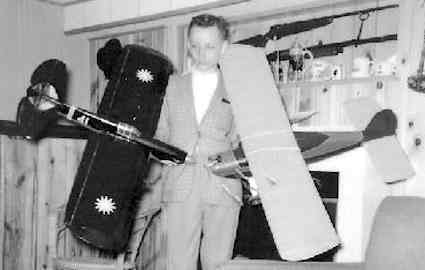
To Reach Ken Myers, you can land mail to the address at the top of the page. My E-mail address is: KMyersEFO@theampeer.org |
